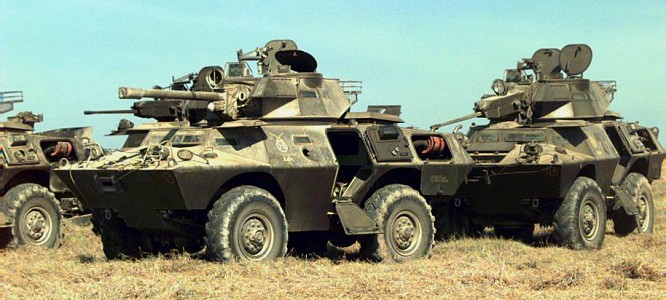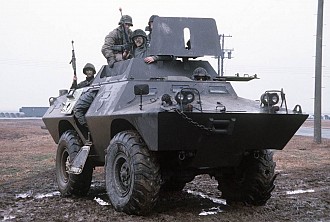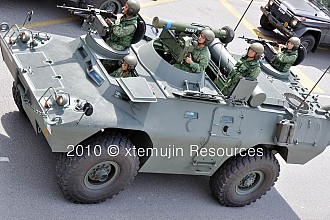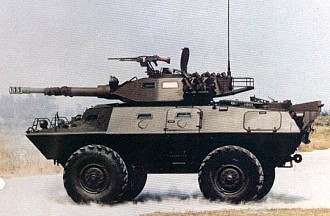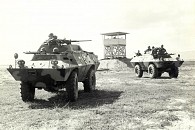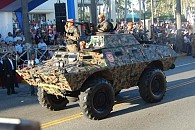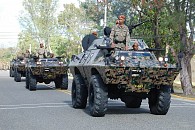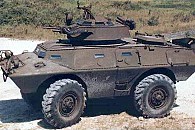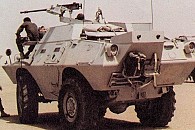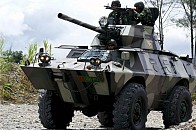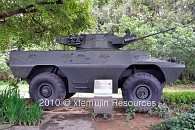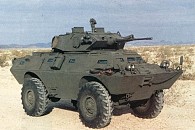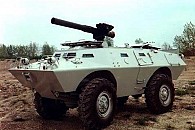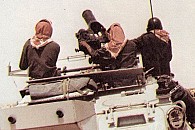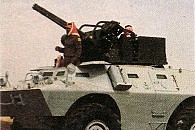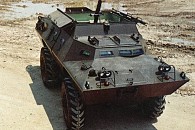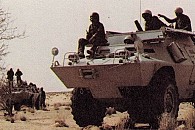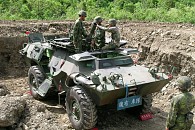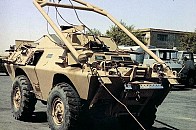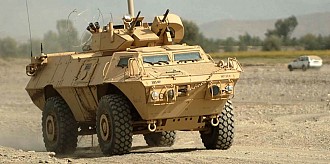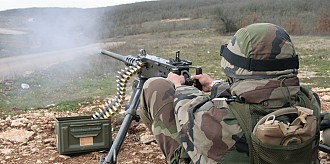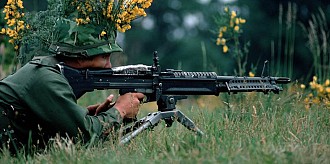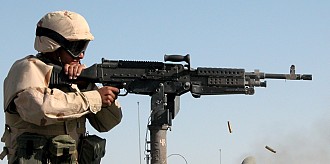Combat vehicles / Reconnaissance / Cadillac Gage Commando
Cadillac Gage Commando
General Facts
- TYPE
Reconnaissance vehicle - ORIGIN
 United States
United States - NICKNAMES
V-100 / V-150 / V-200
LAV-150 (V-150 renamed since 1994)
M706 (US service) - DESIGNED
1961 - 1963 - DESIGNER
Cadillac Gage - PRODUCTION
1964 - at least 1994 - PRODUCERS
 United States - Cadillac Gage
United States - Cadillac Gage
 United States - Textron Marine & Land Systems
United States - Textron Marine & Land Systems - QUANTITY
Over 3.347 produced, including at least 2480 V-150 - UNIT COST
$ 280.000 to $ 350.000 for V-150S with armament in 1992 - CHARACTERISTICS
 Highly mobile on roads and dirt roads
Highly mobile on roads and dirt roads
 Limited production costs
Limited production costs
 Heavy weapons available
Heavy weapons available
 Parts commonality with
Parts commonality with
 Amphibious
Amphibious
 Limited armor protection
Limited armor protection
 Automotive problems in arduous terrain
Automotive problems in arduous terrain
Introduction
The Commando is an early Cold War era armored car of US origin. It was developed in the early 1960's as a private venture. The Commando can be used in various roles, including armored personnel carrier, reconnaissance vehicle and weapons carrier. Early models were actively used in the Vietnam war and many were sold to nations allied to the USA until the early 1990's. The Commando is the predecessor of the contemporary ASV-150 / M1117 Guardian.
Layout
The Commando uses an angled monocoque steel hull and 4x4 chassis with large roadwheels. The driver and commander are seated in the front, the crew compartment is located in the middle and the engine is mounted at the rear. Hatches are located in the roof and there is a door on each side. Various types of turrets can be fitted. Firing ports and vision blocks allow personal firearms to be used from within the vehicle.
Firepower
Most versions of the Commando are armed with one ore more 7.62mm machine guns or 12.7mm heavy machine guns. Various nations acquired models with a two man turret with a non-stabilized 20mm Oerlikon 204 GK autocannon. These are able to engage all types of armored vehicles except tanks. In the fire support role the Commando can be used with a two man turret with 90mm MECAR or Cockerill cannon. These carry a total of 39 90mm rounds. Specialist weapon carriers were produced in limited numbers and include 20mm Vulcan air defense vehicle, tank destroyer with TOW missiles and 81mm, 107mm or 120mm mortar carriers.
Protection
The monocoque hull made out of high strength steel provides protection from small arms fire and shell splinters over all angles. Various models use pintle mounted machine guns that have the gunner exposed while operating the weapon. Smoke grenade launchers are optional. NBC protection systems are missing.
Mobility
The Commando proved to be highly mobile on roads. The large roadwheels provide reasonable cross country performance. A 200 hp petrol or diesel engine allows for road speeds up to 100 km/h. The V-100 models suffered from limited reliability since the weight exceeded design parameters of the automotive parts used. Later models had much improved reliability and newer engines allowed for higher road speeds and improved range. All Commando models are amphibious.
Users
The Commando was adopted by South Vietnam and actively used during the Vietnam war. The US Army and Air Force acquired the Commando as the M706 for use in various support roles. The V-150 is the most numerous model and was exported to various nations in Asia, the Middle East and South America. The vast majority has been replaced, but several hundred Commando remain in service today.
V-100
The V-100 is the original model of the Commando. At first it was known just as the Commando. The V-100 designation was used several years later. It is also known under the US military designation or M706. Although the V-100 was trailed with various turrets with machine guns, grenade launchers and 20mm autocannon. Only a number of relatively basic models saw service.
Models of the V-100 that saw active service include:
- V-100 early production model with a single machine gun on pintle mount.
- V-100 early production model with large one man turret with two machine guns.
- XM706, a V-100 with small twin 7.62mm machine gun turret used by the US Army. Standardized as M706. Later models and conversion kits allowed for one of the 7.62mm machine guns to be replaced by a 12.7mm M2HB heavy machine gun.
- XM706E1, a V-100 with parapet instead of turret. Multiple pintle mounts allow for 7.62mm and 12.7mm machine guns.
- XM706E2, a V-100 with standard roofline and partial parapet for protection. Used by the US Air force as base security vehicle.
- Specifications:
- V-100
| Type | Armored personnel carrier |
|---|---|
| Crew | 3 + 7 |
| Length | ? |
| Width | ? |
| Height | ? |
| Ground clearance | ? |
| Weight | 7.37 t gross vehicle weight |
| Ground pressure | ? |
| Wheelbase | Wheeled chassis, 4x4, 2.67 m wheelbase, 14.50 x21 tires |
| Turn radius | 8.4 m |
| Engine | Chrysler 361 V8 petrol, 200 hp at 4.000 rpm |
| Power ratio | 27.1 hp/t |
|---|---|
| Transmission | Manual, 5 forward, 1 reverse |
| Speed | 100 km/h on road |
| Fuel | ? |
| Range | ? |
| Wall | ? |
| Trench | ? |
| Gradient | 60% gradient, 30% slope |
| Fording | Amphibious |
| Armor | Steel |
| NBC equipment | No |
| Night vision | No |
|---|---|
| Smoke | No |
| Remarks | - |
| Armament | 2x 7.62mm machine gun |
| Weapon1 | Twin 7.62mm machine gun in one man turret 3.800 rounds 2x 400 ready to fire -13 to +55° elevation, manual 360° traverse, manual non-stabilized |
| Weapon2 | - |
| Weapon3 | - |
| Weapon4 | - |
| Weapon5 | - |
| Weapon6 | - |
V-200
The V-200 is an enlarged version of the V-100. It was developed at the request of Singapore. The V-200 is longer, has a more powerful engine and uses strenthened automotive parts that are also used on US Army 5-ton trucks. Advantages over the V-100 are increased reliability, increased internal space and much improved cargo capacity.
Singapore employed the following variants:
- V-200 with two man turret with 20mm Oerlikon and MAG coaxial and roof machine gun.
- V-200 with two man turret with 90mm MECAR gun and MAG coaxial and roof machine gun.
- V-200 armored recovery vehicle with winch and A-frame.
- V-200 mortar carrier with 120mm mortar firing through two large roof hatches.
- V-200 with RBS-70 surface to air missile in one man open roof pedestal mount. Also features two hatches with a pedestal mounted 7.62mm MAG machine gun.
- Specifications:
- V-200
| Type | Armored personnel carrier |
|---|---|
| Crew | ? |
| Length | ? |
| Width | ? |
| Height | ? |
| Ground clearance | ? |
| Weight | 12.73 t gross vehicle weight |
| Ground pressure | ? |
| Wheelbase | Wheeled chassis, 4x4 |
| Turn radius | ? |
| Engine | Chrysler 440 CID 275 hp |
| Power ratio | 21.6 hp/t |
|---|---|
| Transmission | ? |
| Speed | 96 km/h on road |
| Fuel | ? |
| Range | ? |
| Wall | ? |
| Trench | ? |
| Gradient | 60% gradient, 30% slope |
| Fording | Amphibious |
| Armor | Steel |
| NBC equipment | No |
| Night vision | No |
|---|---|
| Smoke | Optional |
| Remarks | - |
| Armament | - |
| Weapon1 | - |
| Weapon2 | - |
| Weapon3 | - |
| Weapon4 | - |
| Weapon5 | - |
| Weapon6 | - |
V-150
The V-150 was developed when the V-200 was already in production. It can be considered a combination of the V-100 and V-200. The improved V-200 automotive parts were used in a V-100 sized vehicle. The three main models of the V-150 are:
V-150: Baseline V-150 model. Later redesignated LAV-150.
V-150S: Stretched V-150 introduced in 1981. Later redesignated LAV-150 S.
LAV-150 ST: LAV-150 S with turbocharged diesel engine.
The V-150 series was used in a wide variety of configurations:
- Armored personnel carrier with standard roofline and pintle mounted machine gun.
- Armored personnel carrier with parapet and pintle mounted machine guns.
- Armored personnel carrier with one man turret with two machine guns. Models include 7.62mm M73, M60, MAG or 12.7mm M2HB heavy machine gun.
- Command post with parapet and pintle mounted machine gun.
- Reconnaissance vehicle with two man turret with 20mm Oerlikon autocannon.
- Fire support vehicle with two man turret with 90mm MECAR or Cockerill cannon.
- Tank destroyer with parapet and pedestal mounted TOW launcher.
- Recovery vehicle with winch and forward mounted A-frame.
- Mortar carrier with 81mm M29 mortar on turntable in parapet. Taiwan converted some standard roofline V-150S APC's with 107mm M30 mortar.
- Ambulance without armement.
Various prototypes used different turrets, such as a one man 20mm turret, a two man 25mm turret and a two man turret with 76mm gun.
- Specifications:
- V-150 (20mm gun)
- V-150 (90mm gun)
- V-150 (command post)
- V-150 (TOW)
- V-150 (81mm mortar)
- V-150ST (20mm gun)
| Type | Reconnaissance vehicle |
|---|---|
| Crew | 3 + 2 (commander, driver, gunner, 2 troops) |
| Length | 5.69 m (hull) |
| Width | 2.26 m |
| Height | 1.98 m (hull top), 2.54 m (turret roof) |
| Ground clearance | 0.38 m |
| Weight | 9.89 t gross vehicle weight |
| Ground pressure | ? |
| Wheelbase | Wheeled chassis, 4x4, 2.67 m wheelbase, 14.50 x21 tires |
| Turn radius | 8.4 m |
| Engine | V-504 V8 diesel, 202 hp at 3.300 rpm |
| Power ratio | 20.4 hp/t |
|---|---|
| Transmission | Manual, 4 forward, 1 reverse |
| Speed | 88 km/h on road, 5 km/h in water |
| Fuel | 300 L |
| Range | 640 km |
| Wall | 0.6 m |
| Trench | ? |
| Gradient | 60% gradient, 30% slope |
| Fording | Amphibious |
| Armor | Steel |
| NBC equipment | No |
| Night vision | No |
|---|---|
| Smoke | Optional |
| Remarks | - |
| Armament | 20mm Oerlikon autocannon 7.62mm coaxial machine gun 7.62mm roof machine gun |
| Weapon1 | 20mm Oerlikon 204 GK autocannon in turret 400 rounds, 200 ready to fire -8 to +60° elevation, 40°/s powered 360° traverse, 60°/s powered non-stabilized |
| Weapon2 | 7.62mm coaxial machine gun 3.200 rounds in total, 400 ready to fire elevation and traverse as main armament |
| Weapon3 | 7.62mm machine gun on turret roof 3.200 rounds in total, 200 ready to fire manual traverse and elevation non-stabilized |
| Weapon4 | - |
| Weapon5 | - |
| Weapon6 | - |
| Type | Fire support vehicle |
|---|---|
| Crew | 3 + 4 (commander, driver, gunner, 4 troops) |
| Length | 5.69 m (hull) |
| Width | 2.26 m |
| Height | ? |
| Ground clearance | 0.38m |
| Weight | 9.89 t gross vehicle weight |
| Ground pressure | ? |
| Wheelbase | Wheeled chassis, 4x4, 2.67 m wheelbase, 14.50 x21 tires |
| Turn radius | 8.4 m |
| Engine | V-504 V8 diesel, 202 hp at 3.300 rpm |
| Power ratio | 20.4 hp/t |
|---|---|
| Transmission | Manual, 4 forward, 1 reverse |
| Speed | 88 km/h on road, 5 km/h in water |
| Fuel | 300 L |
| Range | 640 km |
| Wall | 0.6 m |
| Trench | ? |
| Gradient | 60% gradient, 30% slope |
| Fording | Amphibious |
| Armor | Steel |
| NBC equipment | No |
| Night vision | No |
|---|---|
| Smoke | Optional |
| Remarks | - |
| Armament | 90mm MECAR or Cockerill gun 7.62mm coaxial machine gun 7.62mm roof machine gun |
| Weapon1 | 90mm MECAR or Cockerill Mk III gun in two man turret 39 rounds, 8 ready to fire -8 to +28° elevation, 30°/s powered 360° traverse, 30°/s powered non-stabilized |
| Weapon2 | 7.62mm coaxial machine gun 3.200 rounds in total, 400 ready to fire elevation and traverse as main armament |
| Weapon3 | 7.62mm machine gun on turret roof 3.200 rounds in total, 200 ready to fire manual traverse and elevation non-stabilized |
| Weapon4 | - |
| Weapon5 | - |
| Weapon6 | - |
| Type | Armored personnel carrier |
|---|---|
| Crew | 3 + 7 |
| Length | 5.69 m |
| Width | 2.26 m |
| Height | 2.31 m |
| Ground clearance | 0.38m |
| Weight | ? |
| Ground pressure | ? |
| Wheelbase | Wheeled chassis, 4x4, 2.67 m wheelbase, 14.50 x21 tires |
| Turn radius | 8.4 m |
| Engine | V-504 V8 diesel, 202 hp at 3.300 rpm |
| Power ratio | ? |
|---|---|
| Transmission | Manual, 4 forward, 1 reverse |
| Speed | 88 km/h on road, 5 km/h in water |
| Fuel | 300 L |
| Range | 640 km |
| Wall | 0.6 m |
| Trench | ? |
| Gradient | 60% gradient, 30% slope |
| Fording | Amphibious |
| Armor | Steel |
| NBC equipment | No |
| Night vision | No |
|---|---|
| Smoke | Optional |
| Remarks | - |
| Armament | 7.62mm roof machine gun |
| Weapon1 | 7.62mm machine gun on pedestal mount 2.000 rounds, 200 ready to fire manual traverse and elevation non-stabilized |
| Weapon2 | - |
| Weapon3 | - |
| Weapon4 | - |
| Weapon5 | - |
| Weapon6 | - |
| Type | Tank destroyer |
|---|---|
| Crew | 4 + 2 (commander, driver, gunner, loader, 2 troops) |
| Length | 5.69 m |
| Width | 2.26 m |
| Height | ? |
| Ground clearance | 0.38m |
| Weight | 8.96 t gross vehicle weight |
| Ground pressure | ? |
| Wheelbase | Wheeled chassis, 4x4, 2.67 m wheelbase, 14.50 x21 tires |
| Turn radius | 8.4 m |
| Engine | V-504 V8 diesel, 202 hp at 3.300 rpm |
| Power ratio | 22.5 hp/t |
|---|---|
| Transmission | Manual, 4 forward, 1 reverse |
| Speed | 88 km/h on road, 5 km/h in water |
| Fuel | 300 L |
| Range | 640 km |
| Wall | 0.6 m |
| Trench | ? |
| Gradient | 60% gradient, 30% slope |
| Fording | Amphibious |
| Armor | Steel |
| NBC equipment | No |
| Night vision | No |
|---|---|
| Smoke | Optional |
| Remarks | - |
| Armament | TOW missile launcher 7.62mm machine gun |
| Weapon1 | TOW missile launcher on pedestal mount 7 missiles, 1 ready to fire -10 to +30° elevation, manual 360° traverse, manual non-stabilized |
| Weapon2 | 7.62mm machine gun on pedestal mount 2.000 rounds, 200 ready to fire manual traverse and elevation non-stabilized |
| Weapon3 | - |
| Weapon4 | - |
| Weapon5 | - |
| Weapon6 | - |
| Type | Self-propelled mortar |
|---|---|
| Crew | 5 (commander, driver, 3 mortar operators) |
| Length | 5.69 m |
| Width | 2.26 m |
| Height | ? |
| Ground clearance | 0.38m |
| Weight | 8.85 t gross vehicle weight |
| Ground pressure | ? |
| Wheelbase | Wheeled chassis, 4x4, 2.67 m wheelbase, 14.50 x21 tires |
| Turn radius | 8.4 m |
| Engine | V-504 V8 diesel, 202 hp at 3.300 rpm |
| Power ratio | 22.8 hp/t |
|---|---|
| Transmission | Manual, 4 forward, 1 reverse |
| Speed | 88 km/h on road, 5 km/h in water |
| Fuel | 300 L |
| Range | 640 km |
| Wall | 0.6 m |
| Trench | ? |
| Gradient | 60% gradient, 30% slope |
| Fording | Amphibious |
| Armor | Steel |
| NBC equipment | No |
| Night vision | No |
|---|---|
| Smoke | Optional |
| Remarks | - |
| Armament | 81mm M29 mortar 7.62mm machine gun |
| Weapon1 | 81mm M29 mortar mounted on turntable 62 mortar bombs carried +40 to +85° elevation, manual 360° traverse, manual non-stabilized |
| Weapon2 | 7.62mm machine gun on pedestal mount 2.000 rounds, 200 ready to fire manual traverse and elevation non-stabilized |
| Weapon3 | - |
| Weapon4 | - |
| Weapon5 | - |
| Weapon6 | - |
| Type | Reconnaissance vehicle |
|---|---|
| Crew | 3 + 2 (commander, driver, gunner, 2 troops) |
| Length | 6.27 m |
| Width | 2.39 m |
| Height | 1.98 m (hull top), 2.69 m (turret roof) |
| Ground clearance | 0.38 m |
| Weight | 10.87 t gross vehicle weight |
| Ground pressure | ? |
| Wheelbase | Wheeled chassis, 4x4, 3.12 m wheelbase, 14.00 x20 tires |
| Turn radius | 8.5 m |
| Engine | 6 CTA V6 turbo diesel, 250 hp at 2.500 rpm |
| Power ratio | 23.0 hp/t |
|---|---|
| Transmission | Automatic, 5 forward, 1 reverse |
| Speed | 112 km/h on road, 5 km/h in water |
| Fuel | 300 L |
| Range | 800 km |
| Wall | 0.6 m |
| Trench | ? |
| Gradient | 60% gradient, 30% slope |
| Fording | Amphibious |
| Armor | Steel |
| NBC equipment | No |
| Night vision | No |
|---|---|
| Smoke | Optional |
| Remarks | - |
| Armament | 20mm Oerlikon autocannon 7.62mm coaxial machine gun 7.62mm roof machine gun |
| Weapon1 | 20mm Oerlikon 204 GK autocannon in turret 400 rounds, 200 ready to fire -8 to +60° elevation, 40°/s powered 360° traverse, 60°/s powered non-stabilized |
| Weapon2 | 7.62mm coaxial machine gun 3.200 rounds in total, 400 ready to fire elevation and traverse as main armament |
| Weapon3 | 7.62mm machine gun on turret roof 3.200 rounds in total, 200 ready to fire manual traverse and elevation non-stabilized |
| Weapon4 | - |
| Weapon5 | - |
| Weapon6 | - |

